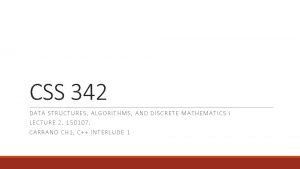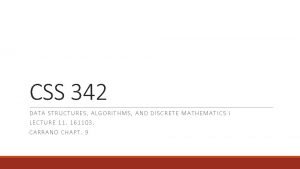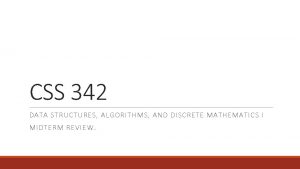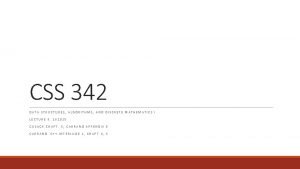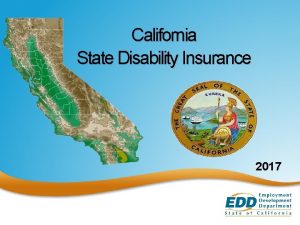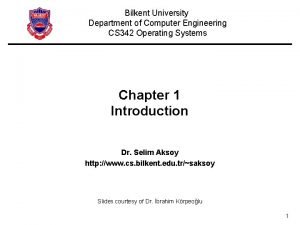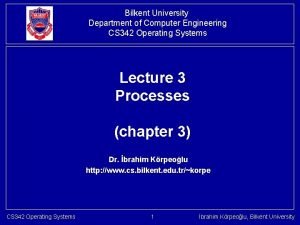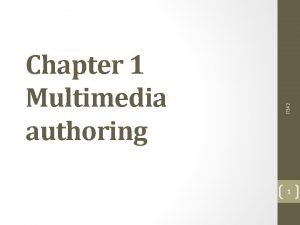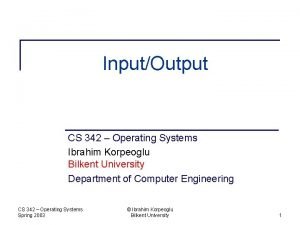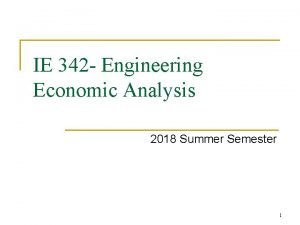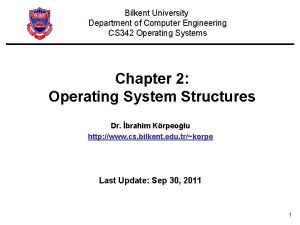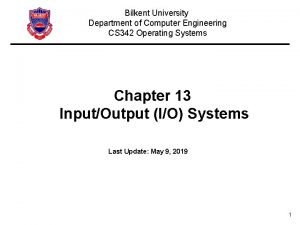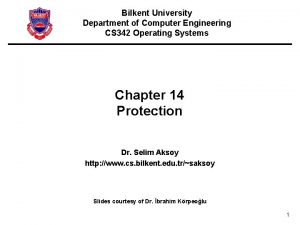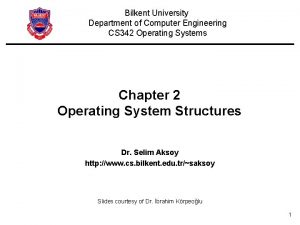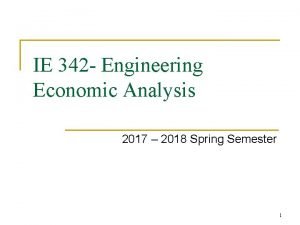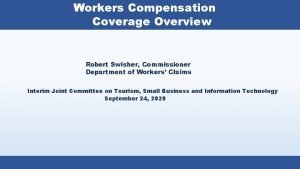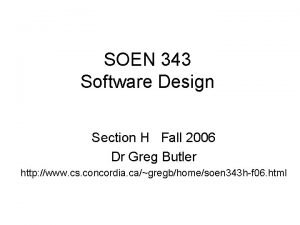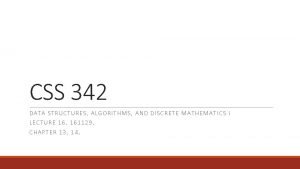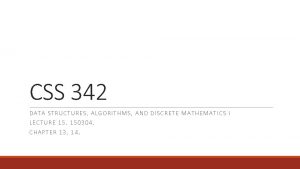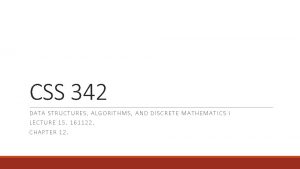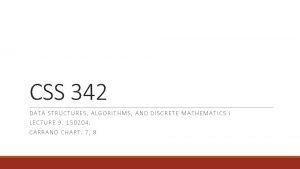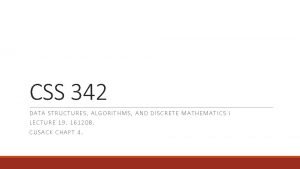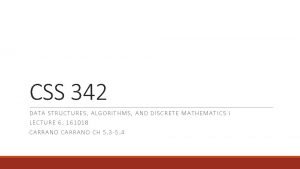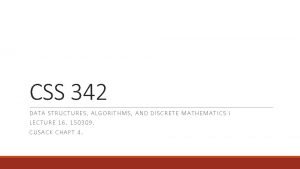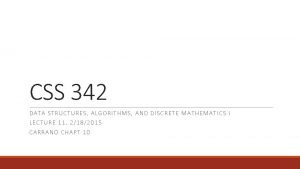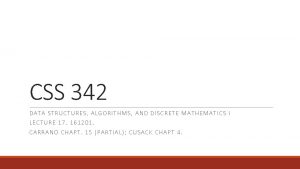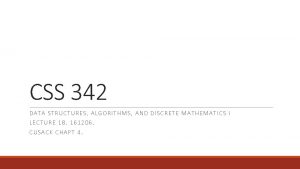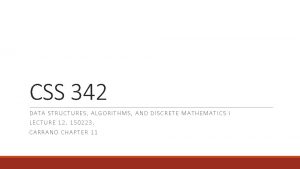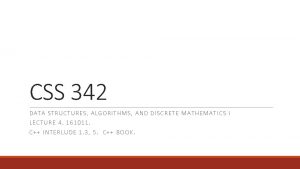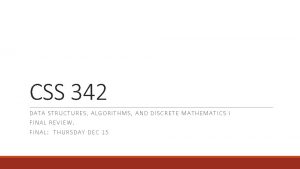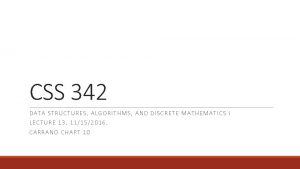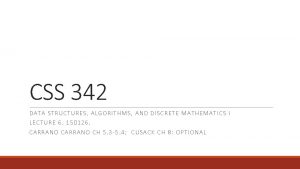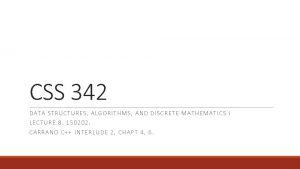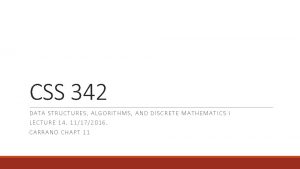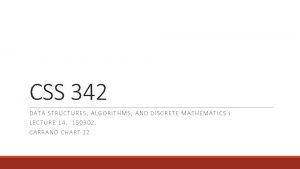CSS 342 DATA S TR U CTURES ALGO





















- Slides: 21

CSS 342 DATA S TR U CTURES, ALGO RITHMS , AND DISCRETE MATHEMATICS I LECTU RE 17. 150311. CUSA CK C HAP T 4.

Agenda • HW 5: Questions / Discussion. • Final Exam: Monday 3/16. • Propositional Logic… Will be on final. • Final Exam Review.

Lab 5: What to turn in http: //courses. washington. edu/css 342/dimpsey/Lab 5. pdf • Turn in: • All. cpp and. h files for your project (incl. stdafx. cpp, stdafx, …) • Output file called Bank. Trans. Out. txt which is your program run against sample input on site • Your. exe or a. out file • How will we grade this? • Place all of your. cpp/. h in a directory and build using • Cl *cpp • g++ *cpp or g++ -std=c++11 *cpp • Run the created. exe/a. out against a number of test Bank. Trans. txt files • PLEASE PRACTICE THIS YOURSELF BEFORE TURNING IN

It’s our last class!!!!

Propositional Logic

Text Book An Active Introduction to Discrete Mathematics and Algorithms, Charles Cusack, David Santos, GNU Free Software, 2014. http: //www. cs. hope. edu/~cusack/Notes/Books/Active%20 Introduction%20 to%20 Discrete%20 Mathematics%20 and%20 Algorithms/Active. Intro. To. Discrete. Math. And. Algorithms. pdf Chapter 4: Logic.

Theorems for Boolean algebra • Commutative Law • • Associative Law • Square Law • p^p =p • pvp=p • pvq=qvp • p^q=q^p • p v (q v r) = (p v q) v r • p ^ (q ^ r) = (p ^ q) ^ r • Distributive Law • p ^ (q v r) = (p ^ q) v (p ^ r) • p v (q ^ r) = (p v q) ^ (p v r) • Identity • pv. F=p • P^T=p • Domination • pv. T=T • p^F=F Complement Law • p ^ ¬p = F • p v ¬p = T • Double Negation • ¬(¬p) = p • Absorption • p ^ (p v q) = p • p v (p ^ q) = p

Precedence of Operators • NOT: ¬ • AND: ^ • XOR • OR: v • Conditional: ->

Prove the following Boolean equations • ¬p ^ q v p ^ ¬q = (¬p v ¬q) ^ (p v q) • p^qvp^q^rvp^¬q=p • (p ^ q v r ) ^ q = p ^ q ^ ¬r v ¬p ^ q ^ r v p ^ q ^ r

Truth Tables • Table iterating all possible combinations for a proposition • Example: p ^ q v p ^ r p q r p^q p^r p^qvp^r 0 0 0 0 1 0 0 0 0 0 1 0 1 1 1 1

Conditional Propositions Given two propositions such as p and q, If p then q or p→q is called a conditional proposition. ◦ P: hypothesis, antecedent, or sufficient condition ◦ Q: conclusion, consequent, or necessary condition

Truth Table of Conditional Propositions Chair Statement: if CSS gets an additional $80, 000, it will hire one new faculty member. P: CSS gets an additional $80, 000. Q: CSS will hire one new faculty member. If both p and q are true, the chair said a correct statement. If p is true but q is false, the chair said a wrong statement. If p is false, the chair is not responsible for his statement. We should regard it as true. p q p→q T T F F F T T F F T

If and only if Given two propositions such as p and q, p if and only if q or p <-> q • Called a bi-conditional proposition. • True when p and q have the same truth value • False otherwise • p iff q • Show the truth table for: • (p <-> q)<-> (q <-> p)

In-class problem Let p, q, and r be the propositions. ◦ p: Grizzly bears have been seen in the area. ◦ q: Hiking is safe on the trail. ◦ r: Berries are ripe along the trail. Write these propositions using p, q, and r and logical connectives. § § § Berries are ripe along the trail, but grizzly bears have not been seen in the area. Grizzly bears have not been seen in the area and hiking on the trail is safe, but berries are ripe along the traile If berries are ripe along the trail, hiking is safe if and only if grizzly bears have not been seen in the area. It is not safe to hike on the trail, but grizzly bears have not been seen in the area and the berries along the trail are ripe. For hiking on the trail to be safe, it is necessary but not sufficient that berries not be ripe along the trail and for grizzly bears not to have been seen in the area. § Hiking is not safe on the trail whenever grizzly bears have been seen in the area and berries are ripe along the trail.

Computer Scientist of the Week Augustus De Morgan • • • British Mathematician and logician (1806 – 1871) De Morgan’s Laws Introduced the term Mathematical Induction Discovered Relation Algebra: extension of Boolean algebra Interested in Spiritualism, Clairvoyance, and psychic phenomenon

De Morgan’s Laws • Show De Morgan’s Law is true • ¬(p ^ q) ≡ ¬p v ¬q • ¬(p v q) ≡ ¬p ^ ¬q p ^q ¬(p ^ q) ¬p ¬q ¬p v ¬q T T T F F T F T F F F T T CSS 342: PROPOSITIONS 16

Logical Equivalence • If two different compound propositions have the same truth values they are called logically equivalent • Show: ¬(p v q) ≡ ¬p ^ ¬q p q pvq ¬(p v q) ¬p ¬q ¬p ^ ¬q T T T F F T F F T T F F F T T CSS 342: PROPOSITIONS 17

Logical Equivalence • Let p and q be propositions • Some definitions: • P is a tautology if it is always true • P is a contradiction if it is always false • P is a contingency if it can be either true or false depending on input • p and q are logically equivalent iff • p=q • p and q have the same truth tables • Also written, q ≡ p • Show: ¬p v q ≡ p -> q

¬p v q ≡ p -> q p q ¬p ¬p v q p -> q T T F T T T F F F T T T

Logical Equivalence if p then q ≡ p only if q ≡ not p or q all called logically equivalent. ◦ If John takes CSS 342, he advances to CSS 343 ◦ John may take CSS 342 only if he advances to CSS 343. ◦ John does not take CSS 342 or he advances to CSS 343.

Logical Equivalence • For each pair of propositions P and Q, show whether or not P ≡ Q. • • • P: p, Q: p v q P: p → q, Q: ¬ q → ¬ p P: (p → q) ^ (q → r), Q: p → r P: (p → q) → r, Q: p → (q → r)
